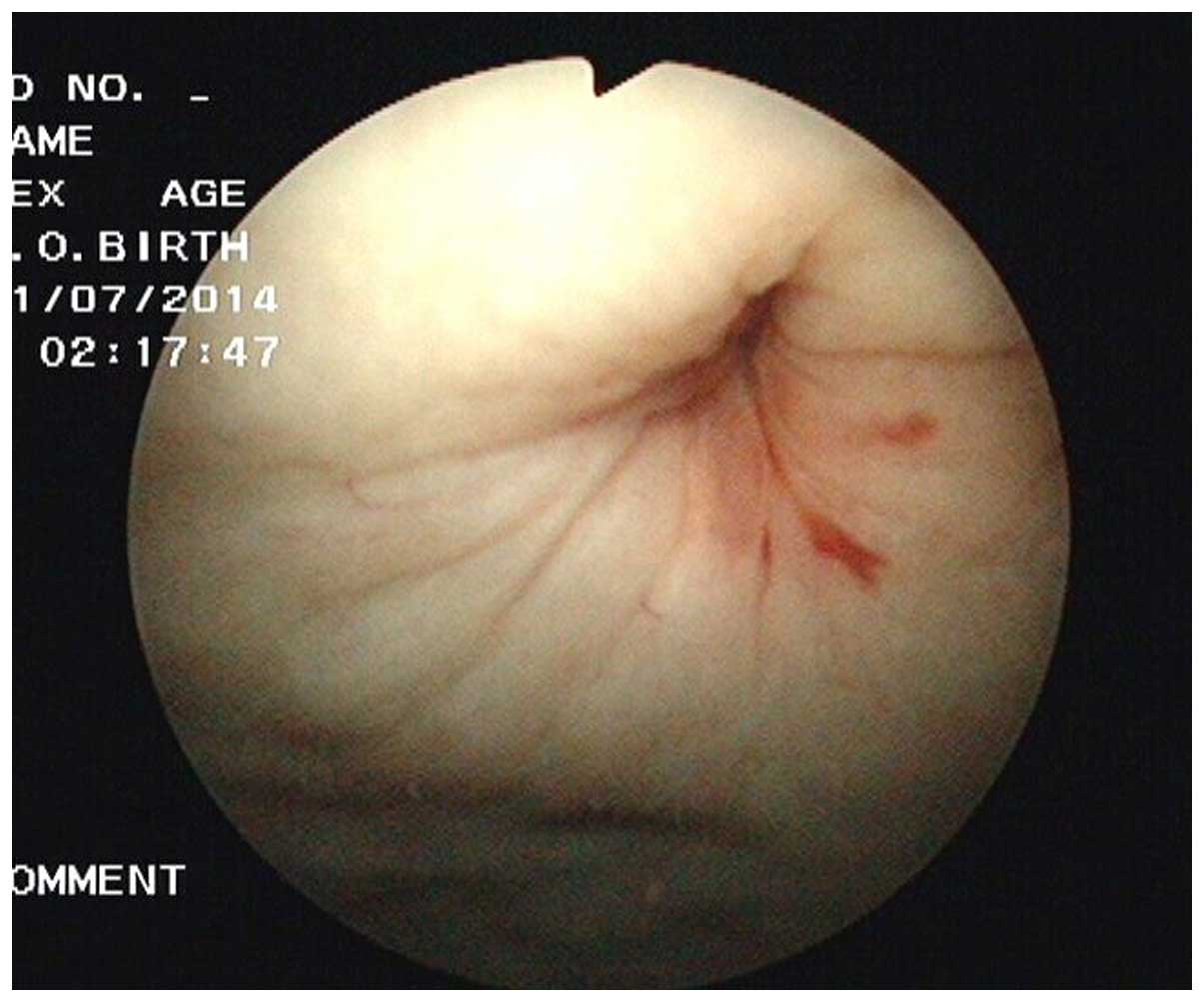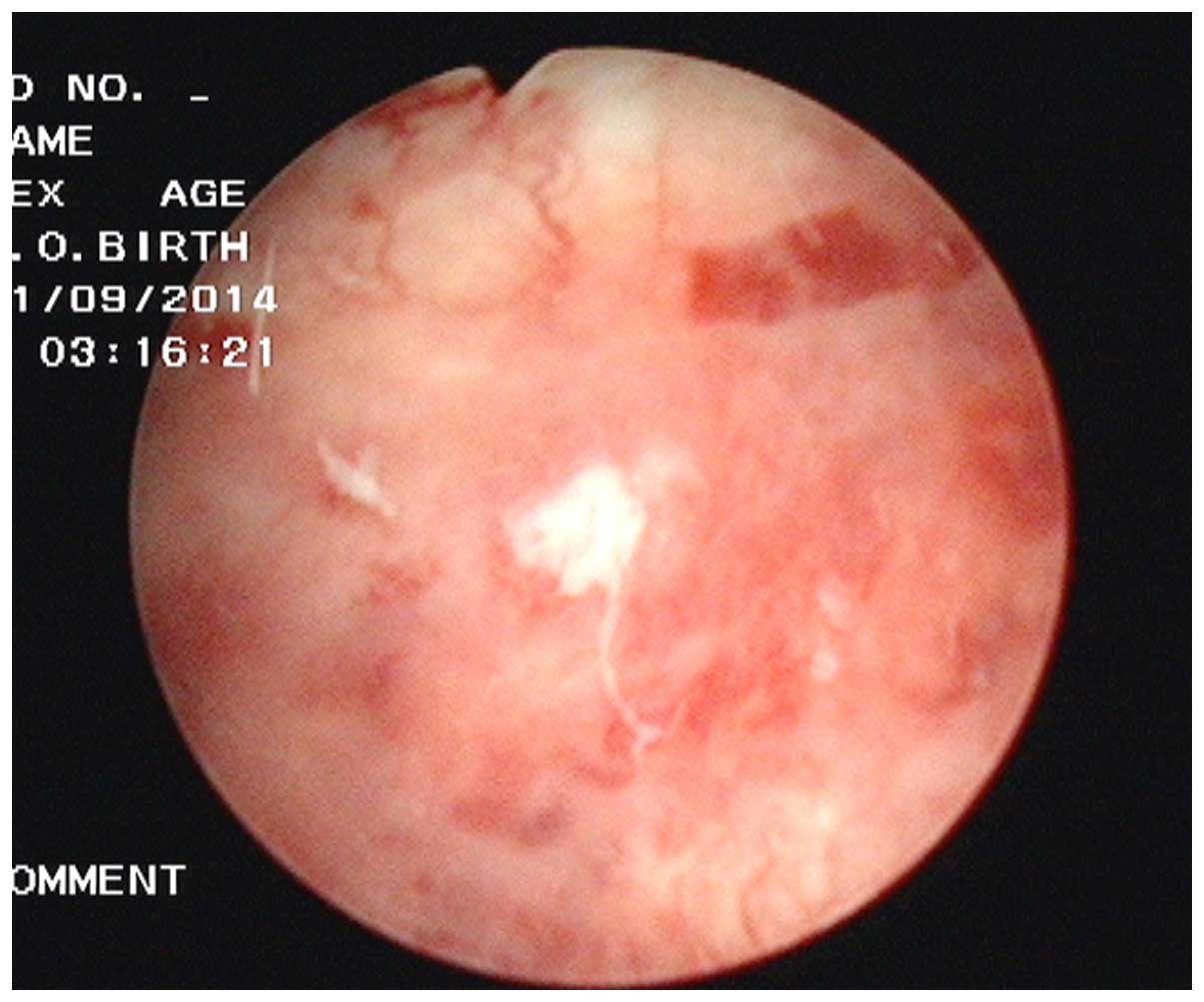Peritoneal bladder fistula following radiotherapy for cervical cancer: A case report
- Authors:
- Fan Shi
- Tao Wang
- Jiquan Wang
- Beina Hui
- Yanlan Chai
- Juan Wang
- Zi Liu
View Affiliations
Affiliations: Department of Radiation Oncology, First Affiliated Hospital of Xi'an Jiaotong University, Xi'an, Shaanxi 710061, P.R. China
- Published online on: July 7, 2016 https://doi.org/10.3892/ol.2016.4820
-
Pages:
2008-2010
Metrics: Total
Views: 0 (Spandidos Publications: | PMC Statistics: )
Metrics: Total PDF Downloads: 0 (Spandidos Publications: | PMC Statistics: )
This article is mentioned in:
Abstract
The occurrence of a peritoneal bladder fistula as a result of radiation cystitis following radiotherapy for cervical cancer is extremely rare and, to the best of our knowledge, has not been reported previously. The present study reports the case of a 50‑year‑old woman who was diagnosed with cervical cancer 20 years previously and was treated with radiotherapy. The patient was diagnosed with radiation cystitis 10 years ago, which was treated with Chinese medicine, and began experiencing sudden abdominal pain and bowel difficulties following urination 3 years ago. B‑ultrasound examination at The People's Hospital of Tongchuan (Tongchuan, China) detected the presence of abdominal pelvic fluid. Following antibiotic (levofloxacin for 5 days) and ascites extraction treatment, symptoms were relieved without recurrence. However, 5 days prior to admission to the First Affiliated Hospital of Xi'an Jiatong University (Xi'an, China) on June 25, 2014, the patient experienced difficulty when urinating, abdominal pain and bloating, but did not experience frequent urination, hematuria or fever. Cystoscopic examination revealed a visible fistula on the bladder wall measuring 1x1 cm in diameter. Cytoscopic examination 1 month after catheterization and ascites extraction revealed no evidence of the fistula. The patient was followed up every 3 months for a year and a half, and is currently alive and well. In conclusion, the occurrence of peritoneal bladder fistula following radiation therapy is rare and cystoscopy is the preferred method of examination and diagnosis. Early detection and treatment may significantly improve the prognosis of patients.
View References
|
1
|
Liem X, Saad F and Delouya G: A practical
approach to the management of radiation induced hemorrhagic
cystitis. Drugs. 75:1471–1482. 2015. View Article : Google Scholar : PubMed/NCBI
|
|
2
|
Cox JD, Stetz J and Pajak TK: Toxicity
criteria of the Radiation Therapy Oncology Group (RTOG) and the
European Organization for Research and Treatment of Cancer (EORTC).
Int J Radiat Oncol Biol Phys. 31:1341–1346. 1995. View Article : Google Scholar : PubMed/NCBI
|
|
3
|
Coman JM, Mcclure D, Pritchett R,
Kozlowski P and Hampson NB: Treatment of radiation induced
hemorrhagic cystitis with hyperbaric oxygen. J Urol. 169:2200–2202.
2003. View Article : Google Scholar : PubMed/NCBI
|
|
4
|
Wit EM and Horenblas S: Urological
complications after treatment of cervical cancer. Nat Rev Urol.
11:110–117. 2014. View Article : Google Scholar : PubMed/NCBI
|
|
5
|
Pourquier H, Delard R, Achille E, Daly NJ,
Horiot JC, Keiling R, Pigneux J, Rozan R, Schraub S and Vrousos C:
A quantified approach to the analysis and prevention of urinary
complications in radiotherapeutic treatment of cancer of the
cervix. A quantified approach to the analysis and prevention of
urinary complications in radiotherapeutic treatment of cancer of
the cervix. 13:1025–1033. 1987.
|
|
6
|
Appelt AL, Bentzen SM, Jakobsen A and
Vogelius IR: Dose-response of acute urinary toxicity of long course
preoperative chemoradiotherapy for rectal cancer. Acta Oncol.
54:179–186. 2015. View Article : Google Scholar : PubMed/NCBI
|
|
7
|
Rosewall T, Catton C, Currie G, Bayley A,
Chung P, Wheat J and Milosevic M: The relationship between external
beam radiotherapy dose and chronic urinary dysfunction - a
methodological critique. Radiother Oncol. 97:40–47. 2010.
View Article : Google Scholar : PubMed/NCBI
|
|
8
|
Kanai A, Epperly M, Pearce L, Birder L,
Zeidel M, Meyers S, Greenberger J, de Groat W, Apodaca G and
Peterson J: Differing roles of mitochondrial nitric oxide synthase
in cardiomyocytes and urothelial cells. Am J Physiol Heart Circ
Physiol. 286:H13–H21. 2004. View Article : Google Scholar : PubMed/NCBI
|
|
9
|
Li A, Sun J and Chao H: Late bladder
complications following radiotherapy of carcinoma of the uterine
cervix. Zhonghua Fu Chan Ke Za Zhi. 30:741–743. 1995.(In Chinese).
PubMed/NCBI
|
|
10
|
Brzozowska A, Idziak M, Burdan F and
Mazurkiewicz M: Symptoms and treatment of radiation-induced
reactions. Pol Merkur Lekarski. 38:283–287. 2015.(In Polish).
PubMed/NCBI
|
|
11
|
Tasdemir N, Abali R, Celik C, Yazici CM
and Akkus D: The use of an anterior abdominal wall peritoneal flap
in the laparoscopic repair of vesicouterine fistula. Int Surg.
99:673–676. 2014. View Article : Google Scholar : PubMed/NCBI
|
|
12
|
Iloabachie GC and Njoku O: Vesico-uterine
fistula. Br J Urol. 57:438–439. 1985. View Article : Google Scholar : PubMed/NCBI
|
|
13
|
Chuang YC, Kim DK, Chiang PH and
Chancellor MB: Bladder botulinum toxin A injection can benefit
patients with radiation and chemical cystitis. BJU Int.
102:704–706. 2008. View Article : Google Scholar : PubMed/NCBI
|











